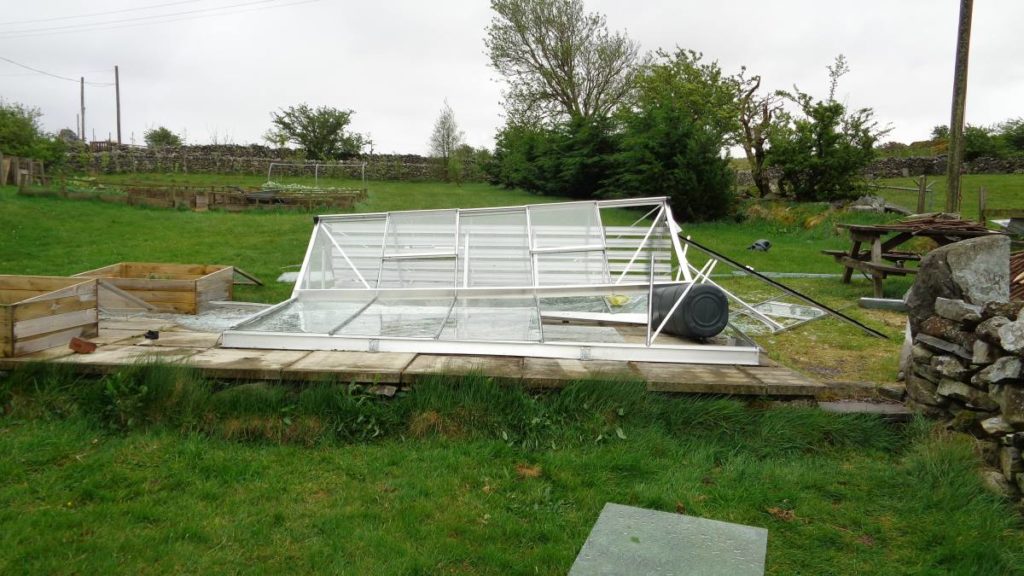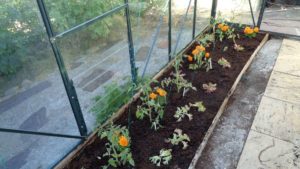I’ve always believed that you should make sure the doors and all the vents are shut to help a greenhouse survive a storm. The rationale is that once the winds get in, they force the glass out and the whole greenhouse is in trouble in short order. It turns out I may have been wrong, at least in part.
I had an email conversation with Jeff Egan. He has an interest in the weather generally and provided an interesting insight into how storms damage greenhouses along with a way to help prevent that damage.
He wrote:
That brings me to a small point in your January newsletter tips, regarding closing up a greenhouse if the weather gets rough.
If high winds are forecast I find it best to leave a vent open a bit on the leeward side of the greenhouse to avoid glass being blown out.
I’ve found from personal experience along with others, that sudden violent gusts can leave broken panes on the ground outside. This is caused not so much by the dynamic pressure of the wind (that would blow the glass inside the greenhouse), but by a sudden drop in pressure around the outside.
A violent sudden gust over the roof, can cause quite a drop in air pressure and if the greenhouse is not ventilated at all the air pressure Inside the greenhouse will remain higher than outside. If the air pressure inside cannot quickly equalise with that outside, something is going to give, usually a pane or two of glass. The greenhouse literally explodes. There is far less chance of this happening if a vent is open a little especially in an urban garden where wind gusts and eddies bounce off walls and fences.
Of course, if the greenhouse is exposed in open fields to very high winds damage of any sort can happen.
He added to this
I came across this problem years ago when I found, after a very windy day, smashed glass outside but none at all inside the greenhouse.
This mostly applies to the cheaper flimsy alloy framed greenhouses with only spring clips holding the glass panes. Good quality wooden framed greenhouses with decent glazing beads would be less vulnerable to this sort of damage.
I also notice when lying in bed on a very windy night, some gusts make the roof creak. Apparently it’s the low pressure difference over the roof and the slightly higher pressure within the house causing the roof tiles to rise a fraction.
Many of the better quality greenhouses use tempered glass in large sheets secured with glazing strips to hold the glass in place. This system is more solid than spring clips but not invulnerable.
I asked how it would work here where the wind seems to change direction in storms. Jeff replied:
I don’t think the wind direction makes much difference. The reason I recommended a leeward (facing downwind) vent being opened a crack is to avoid the vent being lifted off its stay if its facing the wind.
Thinking about it, on both my greenhouses, I’ve got louvre vents low down. These help tremendously with airflow in hot weather. Leaving them part open in a storm may help the greenhouse equalise those pressure differences and thereby save the day.
I have seen the whole greenhouse flexing in strong winds and only thought about the push of the air on the glass.
Seems like I was missing a trick by stopping the pull as the pressure wave passes.






Hi John,
Thanks for publishing my article.
You mentioned opening the lower louvre vents to equalise inside and outside pressure during strong winds.
What a great idea! I wish I’d thought of that.
In your February article, you spoke about windchill, and how you demonstrated this to your Grandson by wetting your hand and blowing across it. That’s a good way of explaining it.
For those who might be Interested, it’s a process known as evaporative cooling. The air passing over evaporates the water taking heat with it very efficiently.
We often get snow showers forming over the North sea, and being blown inland by the same process. Some meteorologists call this Lake snow.
In the atmosphere this also often happens when the humidity is high in cold weather.
Falling rain often cools the air sufficiently enough to turn the rain to sleet or wet snow.
Cheers
Jeff.
Thanks, as always, Jeff.
Over the last three months I have re-glazed and repaired five greenhouses including my own on our Leg Of Mutton allotment site here in Earsdon, Whitley Bay. You make an interesting point about leaving a vent slightly open on the leeward side to the wind to reduce the internal pressure difference and thereby stop any panes blowing out. I have disconnected my autovents in my wooden potting shed, 8x 6 greenhouse, but not my old Crittall lean-to. After Storm Malik a large pane exploded outwards from the latter into small square pieces – it’s toughened glass. It is about 6′ away from a 6′ boundary fence. I am thinking the drop in pressure between the fence and the lean-to caused the corner pane to pop out. Or is it because I didn’t leave a vent open?
My 8×10 gh now six years old is built on a concrete base a good 4″ deep. The GH lies on an exposed site with open fields in abundance. Ridge is on a near South West axis. The winds and rain can be fearsome and scary at night but the gh appears to brush it aside. Four upper vents auto controlled and two lower which I usually keep fractionally open over winter – just for breathing. The glass is 4mm toughened. I have no idea if there are any clues here – not forgetting – fingers crossed.
West London here, just checked my greenhouse and 100% of glass is still in place.
I have always left a side vent slightly open and seems to work.
Not windy today here but maybe the “clam before the storm” looking at the weather forecast.
One thing I found out many years ago is that the standard four clips per pane of glass isn’t sufficient on exposed sites or in my case, wind tunnels.
Once this was increase to six per pane, my 8×6 Halls greenhouse withstood gusts up to a recorded(I have a weather station) 96mph.
My greenhouse is a cheap flimsy plastic panelled type and I back onto fields. We have strong winds here. There is no choice for me. Both door and window have to be closed as otherwise I’d be trying to find panels all up my road. Although very rarely in the fields. I’ve learned my lesson . In the summer it’s different, but maybe it’s because winds are from different direction and not to intense ???
I have just got an Eden 8X12 (John recommended!) so only a few broad beans ect coming through at present. I alway thought it was best to keep it tight in winy weather so I have just sent the wife out to open the doors (on the leeward side) an couple of inches. I haope we can all escape unscathed.
Glenn in Maidstone
17/2/2022
I checked my 6′ x 8′ greenhouse this morning to find that I’d left the door open when calm yesterday and thus 2 toughened side wall sheets of glass had blown out but as they weren’t damaged found the clips and re-affixed them. The door is now closed and waiting for Eunice!
When will people learn ,Just got back from allotment cleaned up after poor prep caused by quick fix greenhouse down ,Some people must have more money than sense